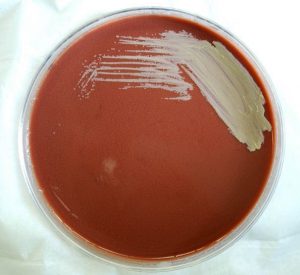Mitchell Brown has been in the bug business for about 18 years and is now a Senior Hospital Scientist of a General Microbiology Unit. He works at the Centre for Infectious Diseases and Microbiology at NSW Health Pathology – Westmead. He will be in the lab over the Christmas period helping those unfortunate people who are sick during holiday season.
Mitchell told us about how he ended up working in pathology and what he enjoys about his job.
What attracted you to pathology and what made you decide to specialise in microbiology?
I always had a keen interest in nature as a child and that led me into science at school. From there it was a gradual progression from biology and basic sciences in high school to my first degree, a BSc in Biomedical sciences. I worked as a zookeeper while I was studying, and did have some early exposure to microbiology and infectious diseases there, particularly when I needed to help vets give antibiotics to sick animals. The kangaroos and wallabies were sometimes affected by a bacterial infection known as ‘lumpy jaw’ which is one of the things that got me interested in microbiology.
What does a typical day involve?
My lab is a core microbiology lab. We operate on a 24/7 basis, every day of the year. I must say I don’t really have a typical day. I could be reading plates at 2am, or visiting one of our partner labs in regional NSW, or perhaps spending a day in the office catching up on admin.
What are the most common conditions that you deal with?
It would have to be Staphylococcus aureus infections. People often refer to it as golden staph. I’m also doing my PhD on the bug so it takes up a big part of my day! It causes a wide variety of skin and soft tissue infections as well as blood stream infections, and infections in other normally sterile sites.
What is the rarest or most unusual condition you have come across?
I was involved in the diagnosis of a case of tularaemia* from someone bitten by a possum in Tasmania. It was the first case in the Southern Hemisphere. It’s a dangerous bug that has to be handled really carefully in the laboratory. That was really enjoyable to work on, and we also got into the Readers Digest in a focus article about the case. They even interviewed the patient.
Do your family and friends understand what you do?
I think they mostly have only a vague understanding of what I do. Some of my family and friends are quite intrigued by it though. It can be hard to explain the finer points of what I do to non-microbiologists, but I do try from time to time.
I think the general public think pathology is all about blood tests that look at chemistry, and perhaps people are familiar with looking at biopsies in anatomical pathology to detect cancer. We are always thinking about how we could do a better job of letting them know what we are all about in microbiology.
Mitchell also took part in a laboratory tour with Chris Bowen MP earlier this year:
What do you like most about your job?
As well as working with a great team of scientists at Westmead, I really like the interaction with rural labs as part of my role is supporting microbiology testing in our more remote locations. We are using some cool technology now that means we can read plates on a computer screen instead of holding the plate in our hands. This is a great tool for consulting with labs in more remote areas as you can look at the same plate as an image on the screen and discuss it in real time over the phone or online. Before we started using this technology some samples would need to be sent from a rural location to our lab, and rural staff were no longer involved in the testing process. Now they can be, and we can get results back to clinicians and patients faster.
Has anyone particularly inspired you in your current role or future career plans?
I’ve worked with a lot of great scientists and doctors in my 18 years in microbiology. Many have encouraged or inspired me in different ways. I’ve also had a lot of exposure to scientists and academics from outside my normal sphere through my involvement in the Australian Society for Microbiology.
What’s it like working in the lab over Christmas?
Christmas can seem like it’s a quieter time, however it can actually be quite hectic as people still get sick and need pathology. The hospital operates 24/7 and therefore so does pathology.

* Tularaemia is a rare infection caused by the bacteria Francisella tularensis. It is a zoonotic disease meaning it can be passed from animals to humans. Symptoms vary depending on where the disease enters the body. The eyes, mouth, lungs and skin can be affected in different ways and symptoms can also include vomiting, diarrhoea and exhaustion. It can be serious if left undiagnosed but treatment with antibiotics is usually successful, particularly when the bacteria is detected early.

